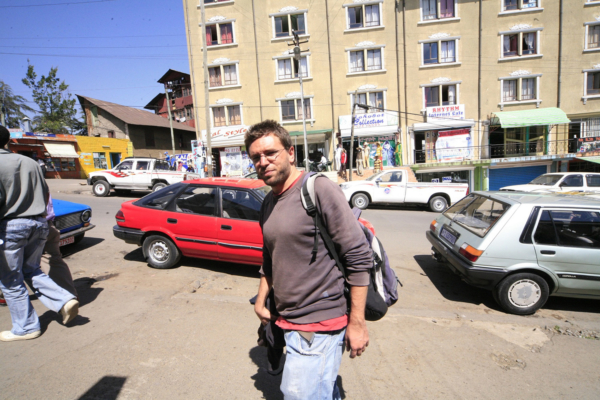
In 2012, Marco Di Nunzio, DPhil in Social and Cultural Anthropology, was granted a two-year fellowship to pursue his research on the topic “Tales of the Unequal City. Political Control and Social Inequality in Addis Ababa” under the supervision of Prof. Mathieu Hilgers at the Laboratoire d’Anthropologie des Mondes Contemporains (LAMC) of the ULB.
How did you come to be interested in Addis Ababa?
At the University of Naples, where I studied Archeology of Africa, my professors focused on Ethiopia for “postcolonial” reasons, so it seemed the natural choice when I had to decide on which country to focus at the time of my Master’s Degree. My first research was on Axum, in Northern Ethiopia, one of the country’s oldest cities. This is where the ancient kingdom of Ethiopia was established two centuries before Christ. It was also the first city to be christianized in the 4th century AD. My research was mainly about youth and contemporary transformations. In 2007, on my way to Axum I stopped in Addis, where I stayed one week, and I was actually scared! It was my first time in a big African city. I saw all these buildings popping up, and I was struck by the contrast between these huge buildings and the wooden scaffoldings.
Addis then became the topic of your PhD? Yes. Just as I had done in Axum, I wanted to focus on youth. A key event in Addis were the elections in May 2005 – the third national elections since the end of the socialist regime in 1991. The ruling party, the EPRDF, knew it was going to win, but it still wanted to have some form of legitimacy in the eyes of international donors. So it opened a space for opposition to campaign, and many young people supported the opposition. After the elections the ruling party said it had won before the official results actually came out. People got worried that elections were being rigged and demonstrations started in July. The government reacted with repression and in the following months 200 people were killed in Addis and 30,000 people were detained in the whole country. The ruling party thought that the reason there had been so many protests was youth unemployment, so it started running employment programmes. There were also other initiatives, targeting specific parts of the population. In Africa you go around a lot with mini-buses, and at each minibus stop there’s someone telling you where to go – local gangs controlling the area, to whom drivers pay a certain fee. The government managed to get these people on its side by legalizing their activity, and in turn they started enforcing government control.
The 2010 UN Habitat Report describes Addis as an “example of positive impact of good leadership”. Would you agree?
When the ruling party realized it was losing ground in the city, it appointed a mayor in 2003, Arkebe Oqubay. At the time the administrative structure of the city was being reshaped. This mayor was one of the country’s top politicians, a very clever man who promoted social programmes benefiting poor people. For example, container shops were made available for rent at very good prices. People in Addis will tell you that he was a very good mayor, who transformed the city significantly. And in a way it is true, the city has changed a lot since then, the transport system is expanding, but the problem is that this evolution is not really negotiated. For example, recently an entire area of the city has been dismantled in Arat Kilo, one of the oldest neighborhoods. People who owned their house got a very low compensation and were moved to the suburbs without any kind of negotiation.
Is this what you call “politically-controlled participatory urban development”? Isn’t that a contradiction? The ruling party talks about participation, but this has a lot more to do with mobilization. Basically they decide the frame in which citizens should participate and then people are mobilized. And the ruling party is very effective in mobilizing people because it is present at all the levels of the state, in all the youth organisations, women’s organisations and so on. At any local meeting at least 400 people will show up, but behind these local organisations there is a strong, centralized system of control. The ruling party and its mobilisers are well aware that they’re winning not because Ethiopians like them, not because of what is called fikir (love), or consent – but because there are no alternatives. The opposition is fragmented, weak, some of its ideas were criticized (they wanted to privatize the land). But although it is true that a huge percentage of the population voted for the ruling party, the presence of an expanded apparatus of political control played a huge role in affecting the electoral result.
This doesn’t seem to bother international donors…
No, because the Ethiopian state is very technocratic and well structured, which allows them to implement programmes efficiently. They can actually deliver, and this sends a good image to the donors’ community, compared to the image of the corrupted African country wasting donors’ money. The paradox is that donors have long preached “less state, more civil society”, and this is not what you have in Ethiopia.
In your postdoctoral research you have analyzed some examples of emerging urban transformations, all linked to the growing social inequalities in Ethiopia.
After the initial mapping I decided to focus on some specific issues. One of them is the evolution of gated communities, which have been appearing over the last ten years, especially in the southeastern area of the city, where the elites started moving since the 1960’s. Then there is another kind of site, the condominiums, which are government-funded. Apartments are assigned through a lottery system. If you get a house, you have to give a down payment of 10 per cent, then you pay the rest as a mortgage. Such buildings have been built everywhere, in the center but also in the suburbs. If you don’t have a car and you end up in one of those condominiums, it can be a problem, because mini-bus rides can get expensive. Right now they’re building a train line that will connect everything. Of course this kind of urban development can be risky: look at what happened in Naples, where the new areas in the suburbs, connected to the city center by highways, have a lot of problems. Moreover these condominiums are built with poor-quality materials. People who live there are nostalgic of their lives in the inner city, where they felt there was more sociality.
Beside Western academics, are African researchers investigating these issues? And do they have a different perspective?
There are specific centers, for example the Forum for Social Studies in Addis,. They’re generally very policy-oriented, identifying problems and potential solutions, Then there is the faculty of Architecture in Addis, where the staff is both local and European, especially from Switzerland. They’re much more critical of the way the city is developing. Many researchers do their PhD abroad and then come back. They are very active. For example, there was a huge campaign about protecting old houses in the city center, and researchers organised a debate and did a mapping of all these buildings.
What will be the next phase of your research project?
I’d like to focus on the business of construction, on the companies involved in the urban development of Addis. Some are supported by the government to build the condominium houses, also because they create jobs. I’d like to look into the history of companies that have been there for a long time, for example state companies under the socialist regime that were later privatized. There are also some Italian companies that have been there since the late 1930s, they had been working in Eritrea and then moved when the Italians occupied Addis in 1936. This colonial and postcolonial history of the building sector is very interesting. These companies are now mainly into big infrastructure projects like dams, for example the multinational Salini. And then of course you have the Chinese companies, working on projects funded by the Chinese government. Finally, there is also a very famous Saudi-Ethiopian businessman, Mohammed Hussein Al Amoudi, who runs a big construction company. The idea is to map this sector and understand better how African cities are being built.


